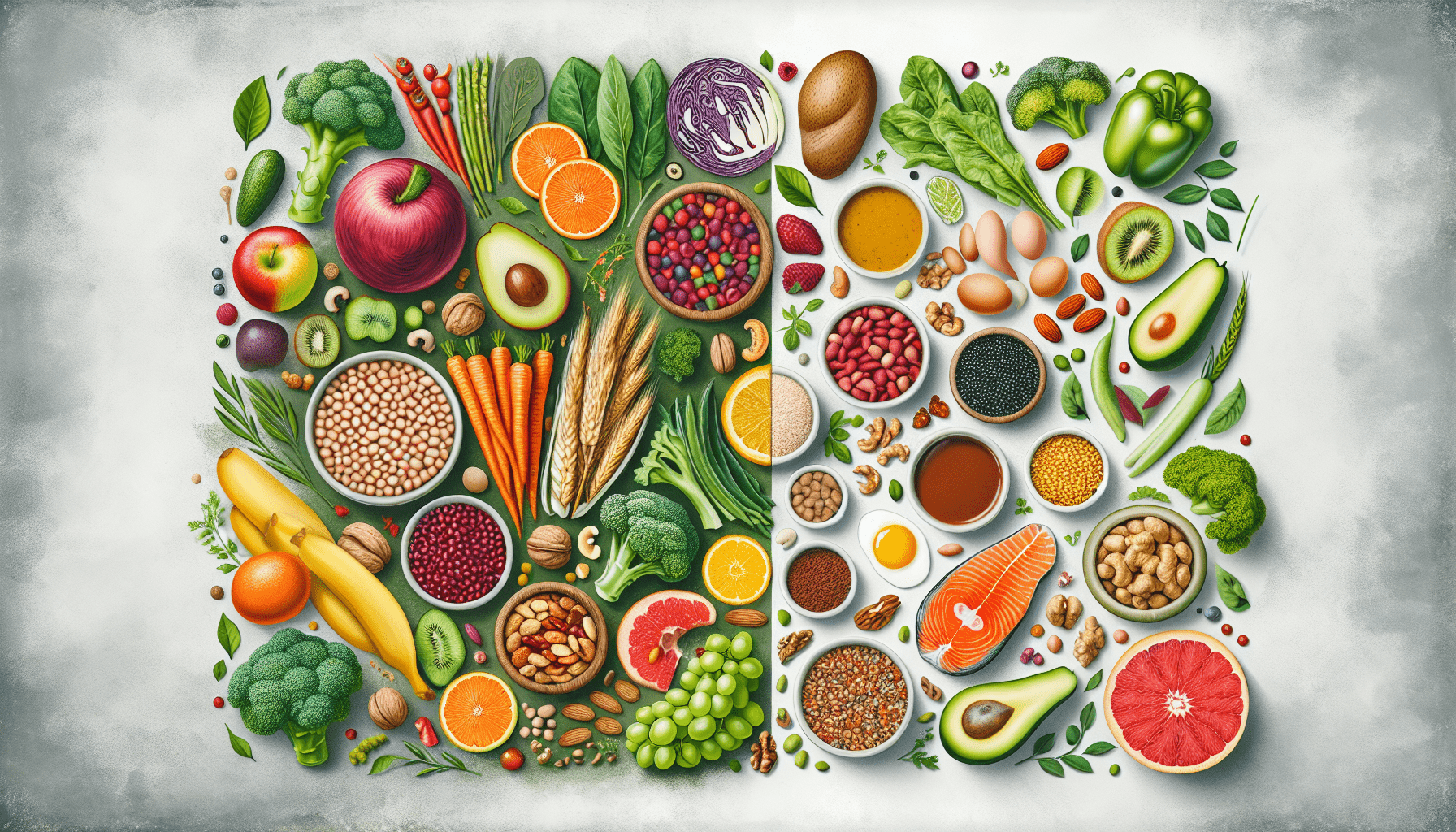Have you ever wondered what the fuss is all about with the Flexitarian Diet? Well, get ready to discover a balanced and flexible approach to healthy eating that’s been gaining popularity worldwide. The Flexitarian Diet emphasizes the inclusion of plant-based foods while still allowing small amounts of meat and other animal products. With its focus on flexibility and moderation, this diet offers a sustainable way to improve your health and the health of the planet. Whether you’re a dedicated vegetarian looking to add some flexibility to your diet or a meat-lover seeking to incorporate more plant-based options, the Flexitarian Diet could be the perfect fit for you.

What is the Flexitarian Diet?
Definition of the Flexitarian Diet
The Flexitarian Diet, as the name suggests, is a flexible and inclusive approach to eating that combines the principles of vegetarianism with occasional consumption of meat. It is not a strict diet with rigid rules, but rather a lifestyle choice that encourages a predominantly plant-based diet while allowing for occasional indulgence in lean meats.
Origins of the Flexitarian Diet
The concept of flexitarianism was coined by registered dietitian Dawn Jackson Blatner in her book “The Flexitarian Diet: The Mostly Vegetarian Way to Lose Weight, Be Healthier, Prevent Disease, and Add Years to Your Life.” The term gained popularity as people started looking for ways to incorporate more plant-based foods into their diets without completely eliminating meat.
Flexitarianism as a lifestyle choice
Flexitarianism offers individuals the flexibility to make choices based on personal preferences and health goals. It provides a balanced and sustainable approach to eating that promotes the consumption of mostly plant-based foods while allowing for occasional inclusion of animal proteins. This way, it caters to a wide range of dietary needs and preferences while still providing the numerous health and environmental benefits associated with a plant-based diet.
Benefits of the Flexitarian Diet
Balanced approach to nutrition
Following a flexitarian diet ensures a well-rounded and balanced approach to nutrition. By emphasizing plant-based foods, such as fruits, vegetables, whole grains, legumes, and nuts, individuals can meet their daily nutrient requirements while minimizing the intake of less healthy foods. This balanced approach provides a wide array of vitamins, minerals, fiber, and antioxidants, which are essential for optimal health and well-being.
Improved weight management
The flexitarian diet offers a flexible and sustainable way to manage weight. By focusing on plant-based foods that are lower in calories and higher in fiber, individuals can maintain a healthy weight or even lose weight if desired. Plant-based meals tend to be more filling due to their high fiber content, helping to control appetite and prevent overeating. Additionally, the occasional inclusion of lean meats can provide additional satiety and satisfaction.
Lower risk of chronic diseases
Adopting a flexitarian diet has been associated with a reduced risk of chronic diseases such as heart disease, diabetes, and certain types of cancer. Plant-based foods are naturally low in saturated fat and cholesterol, which are known risk factors for these diseases. By prioritizing fruits, vegetables, whole grains, and legumes, individuals can ensure a higher intake of beneficial nutrients and antioxidants, which play a vital role in disease prevention.
Sustainability and environmental impact
The flexitarian diet promotes sustainable eating habits and reduces the environmental impact of food production. By limiting the consumption of meat and favoring plant-based proteins, individuals contribute to reduced greenhouse gas emissions, water usage, and deforestation associated with animal agriculture. Additionally, choosing locally sourced and seasonal produce further reduces the carbon footprint. By adopting a flexitarian lifestyle, individuals can make a positive impact on the planet while improving their own health.
Flexitarian Diet Food Guidelines
Plant-based foods
The foundation of the flexitarian diet is plant-based foods. Fruits, vegetables, whole grains, legumes, nuts, and seeds should make up the majority of your meals. Try to incorporate a variety of colors, flavors, and textures to ensure a diverse nutrient intake. Aim for at least five servings of fruits and vegetables per day, opting for fresh produce whenever possible.
Incorporating lean meats
While the flexitarian diet is predominantly plant-based, it does allow for the inclusion of lean meats in moderation. When choosing meats, opt for lean cuts such as skinless poultry, fish, and lean cuts of beef or pork. Limit red meat consumption and opt for grass-fed and organic options when available. Aim for no more than two servings of meat per week or have a vegetarian meal most days of the week.
Reducing processed foods
As with any healthy eating plan, it’s important to limit the intake of processed foods. These foods are often high in unhealthy fats, added sugars, and sodium, and offer little nutritional value. Instead, focus on whole, unprocessed foods that are closer to their natural state. This includes fresh fruits and vegetables, whole grains, and minimally processed foods such as plain yogurt and natural nut butters.
Emphasizing whole foods
Whole foods should be the backbone of your flexitarian diet. These are foods that are unrefined and contain all their natural nutrients. Whole grains such as quinoa, brown rice, and oats provide fiber, vitamins, and minerals. Fresh fruits and vegetables offer a wide range of essential nutrients and antioxidants. Opt for whole versions of foods whenever possible to maximize their nutritional value.
Including dairy and eggs
Dairy products and eggs can be included in the flexitarian diet, but the emphasis should still be on plant-based foods. Choose low-fat dairy options such as skim milk, yogurt, and cheese, and opt for eggs from free-range or organic sources. These animal products can provide important nutrients such as calcium and vitamin D, but should be consumed in moderation.
Flexitarian Diet Meal Planning
Flexitarianism as a flexible eating pattern
One of the key features of the flexitarian diet is its flexibility. The goal is to find a balance that works for you. This may mean having meatless meals most days of the week and enjoying small portions of lean meats on occasion. By allowing yourself the freedom to make choices based on your personal preferences and lifestyle, you are more likely to stick to the diet long-term.
Focus on fruits and vegetables
To plan your flexitarian meals, start by focusing on incorporating a variety of fruits and vegetables. These should be the stars of your plate, providing the majority of your meal’s nutrients and flavors. Experiment with different cooking methods, such as roasting, steaming, or sautéing, to add variety to your meals. Include a mix of raw and cooked vegetables for maximum nutritional benefit.
Preparation of protein-rich meals
While plant-based proteins take center stage in the flexitarian diet, incorporating protein-rich meals is important for satiety and overall nutrition. Legumes such as beans, lentils, and chickpeas, as well as tofu, tempeh, and edamame, are excellent sources of plant-based protein. Experiment with different recipes and cooking methods to discover new flavors and textures.
Balancing macronutrients
When meal planning, aim for a balance of macronutrients – carbohydrates, protein, and healthy fats – in each meal. This helps to provide sustained energy and keeps you feeling satisfied. For example, a balanced meal could include a whole grain, such as quinoa, a plant-based protein source like black beans, and a serving of roasted vegetables, drizzled with a small amount of olive oil for healthy fats.
Smart snacking options
To keep your energy levels up and prevent overeating during meals, incorporate healthy snacks into your flexitarian diet. Opt for fresh fruits, raw nuts and seeds, yogurt, or homemade granola bars. Snacks that combine protein and fiber, such as apple slices with almond butter or hummus with carrot sticks, are particularly satisfying and will keep you feeling full between meals.

Tips for Transitioning to a Flexitarian Diet
Gradual incorporation of plant-based meals
Transitioning to a flexitarian diet can be done gradually to make the process easier and more sustainable. Start by designating one or two days each week as vegetarian or vegan days, and gradually increase the frequency over time. This allows your palate to adapt to new flavors and textures while still giving you the flexibility to enjoy your favorite meat-based dishes.
Experimenting with meat substitutes
If you’re missing the taste and texture of meat, there are a wide variety of meat substitutes available to try. Plant-based meats made from soy, pea protein, or wheat gluten can be used as substitutes in your favorite recipes. Alternatively, you can experiment with mushrooms, tofu, or tempeh to create meaty textures and flavors. Be open-minded and willing to try new ingredients to find options that work for you.
Finding go-to vegetarian recipes
Having a repertoire of delicious and simple vegetarian recipes is key to maintaining a flexitarian lifestyle. Explore vegetarian cookbooks, websites, and blogs for inspiration. Look for recipes that are easy to prepare, flavorful, and satisfying. Find dishes that you genuinely enjoy and make them a part of your regular meal rotation. Having a go-to vegetarian recipe can make meal planning and grocery shopping much easier.
Support from family and friends
Transitioning to a flexitarian diet can be more enjoyable and sustainable with the support of family and friends. Share your goals and reasons behind your dietary choices with them, and invite them to join you on your journey. Plan meals together, swap recipes, and explore new vegetarian or vegan restaurants in your area. Building a support system can make the transition easier and provide you with a sense of community.
Common Concerns and Potential Drawbacks
Iron and vitamin B12 intake
One concern with a flexitarian diet is the intake of certain nutrients, particularly iron and vitamin B12, which are primarily found in animal products. However, by incorporating a variety of plant-based foods, such as legumes, whole grains, and leafy green vegetables, individuals can ensure an adequate intake of iron. Fortified cereals, tofu, and nutritional yeast are good sources of vitamin B12, which can help meet the body’s requirements.
Navigating social situations and dining out
Eating flexitarian can present challenges in social situations and when dining out, as meat-based dishes are often the norm. However, many restaurants now offer vegetarian or vegan options, making it easier to find plant-based choices. When attending social events, offer to bring a vegetarian dish to share or communicate your dietary preferences to the host in advance. By planning ahead and being proactive, you can navigate these situations successfully.
Addressing cravings and food preferences
It’s natural to have cravings for certain foods, especially when transitioning to a flexitarian diet. This is where experimentation and creativity come into play. Look for recipes that mimic the flavors and textures you crave using plant-based ingredients. For example, if you’re craving a burger, try a veggie burger made with black beans or lentils. By finding satisfying alternatives, you can address your cravings while still adhering to your flexitarian lifestyle.
Maintaining balanced nutrition
As with any eating pattern, it’s important to maintain balanced nutrition on a flexitarian diet. Be mindful of your food choices and ensure that you are still meeting your nutritional needs. Focus on variety and include a wide array of fruits, vegetables, whole grains, legumes, and healthy fats. If needed, consider consulting with a registered dietitian to ensure that you are getting all the necessary nutrients your body needs for optimal health.
Flexitarian Diet for Weight Loss
Reduced calorie intake
The flexitarian diet can support weight loss due to its emphasis on plant-based foods, which are generally lower in calories compared to meat and processed foods. By increasing the proportion of plant-based meals, individuals naturally reduce their calorie intake, leading to weight loss over time.
Increased fiber and satiety
Plant-based foods are rich in fiber, which provides a feeling of fullness and helps control appetite. By incorporating more fruits, vegetables, whole grains, and legumes, individuals feel satisfied with their meals and are less likely to indulge in high-calorie, unhealthy snacks. The higher fiber content also improves digestion and supports overall gut health.
Focus on nutritious, low-calorie foods
The flexitarian diet encourages the consumption of nutritious, low-calorie foods such as fruits, vegetables, and whole grains. These foods are nutrient-dense, providing essential vitamins, minerals, and antioxidants while being relatively low in calories. By focusing on these foods, individuals can achieve weight loss while still meeting their nutritional needs.
Long-term sustainability
One of the key advantages of the flexitarian diet for weight loss is its long-term sustainability. Unlike restrictive diets that eliminate entire food groups, the flexitarian diet allows for flexibility and occasional indulgence in favorite foods. This makes it easier to stick to the plan and maintain weight loss over time, promoting a healthy and balanced relationship with food.
Flexitarian Diet and the Environment
Reducing greenhouse gas emissions
By adopting a flexitarian diet, individuals significantly reduce their greenhouse gas emissions. The production of meat, especially beef and lamb, contributes to a large portion of greenhouse gases. By favoring plant-based foods over meat, individuals have a positive impact on climate change and help reduce their carbon footprint.
Preserving natural resources
Animal agriculture requires large amounts of land, water, and feed to sustain the industry. By reducing meat consumption, individuals help preserve natural resources. Plant-based foods require far fewer resources to produce and are more sustainable in the long term. By adopting a flexitarian lifestyle, individuals contribute to the preservation of natural resources for future generations.
Supporting sustainable farming practices
Embracing the flexitarian diet also encourages individuals to support sustainable farming practices. By choosing organic, locally sourced, and ethically produced foods, individuals promote sustainable agriculture and contribute to the well-being of farmers, animals, and the environment. Supporting local farmers’ markets or joining a community-supported agriculture (CSA) program are great ways to align with sustainable food production.
Flexitarian Diet Recipes and Meal Ideas
Breakfast options
- Overnight oats topped with fresh berries, nuts, and a drizzle of honey.
- Scrambled tofu with sautéed vegetables and whole grain toast.
- Banana and spinach smoothie made with almond milk and a scoop of plant-based protein powder.
Lunch and dinner recipes
- Quinoa salad with roasted vegetables, chickpeas, and a lemon-tahini dressing.
- Black bean and sweet potato tacos with avocado and salsa verde.
- Lentil curry with brown rice and a side of steamed broccoli.
Snack ideas
- Apple slices with almond butter.
- Roasted chickpeas sprinkled with paprika.
- Greek yogurt topped with granola and fresh fruit.
Flexitarian meal plans
- Monday: Quinoa salad with roasted vegetables for lunch, and grilled salmon with steamed asparagus and quinoa for dinner.
- Tuesday: Black bean and sweet potato tacos for lunch, and lentil curry with brown rice for dinner.
- Wednesday: Scrambled tofu with sautéed vegetables and whole grain toast for breakfast, and a Mediterranean grain bowl with falafel for lunch.
- Thursday: Overnight oats topped with fresh berries for breakfast, and a veggie stir-fry with tofu for dinner.
Conclusion
The flexitarian diet offers a flexible and inclusive approach to eating that promotes the consumption of mostly plant-based foods while still allowing for occasional inclusion of lean meats. By adopting a flexitarian lifestyle, individuals can enjoy a balanced approach to nutrition, improved weight management, lower risk of chronic diseases, and contribute to sustainability and reduced environmental impact. With its wide range of health and environmental benefits, the flexitarian diet provides a sustainable and friendly path towards improved health and well-being.




